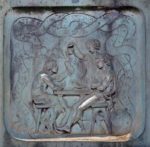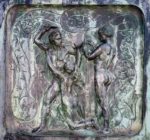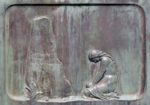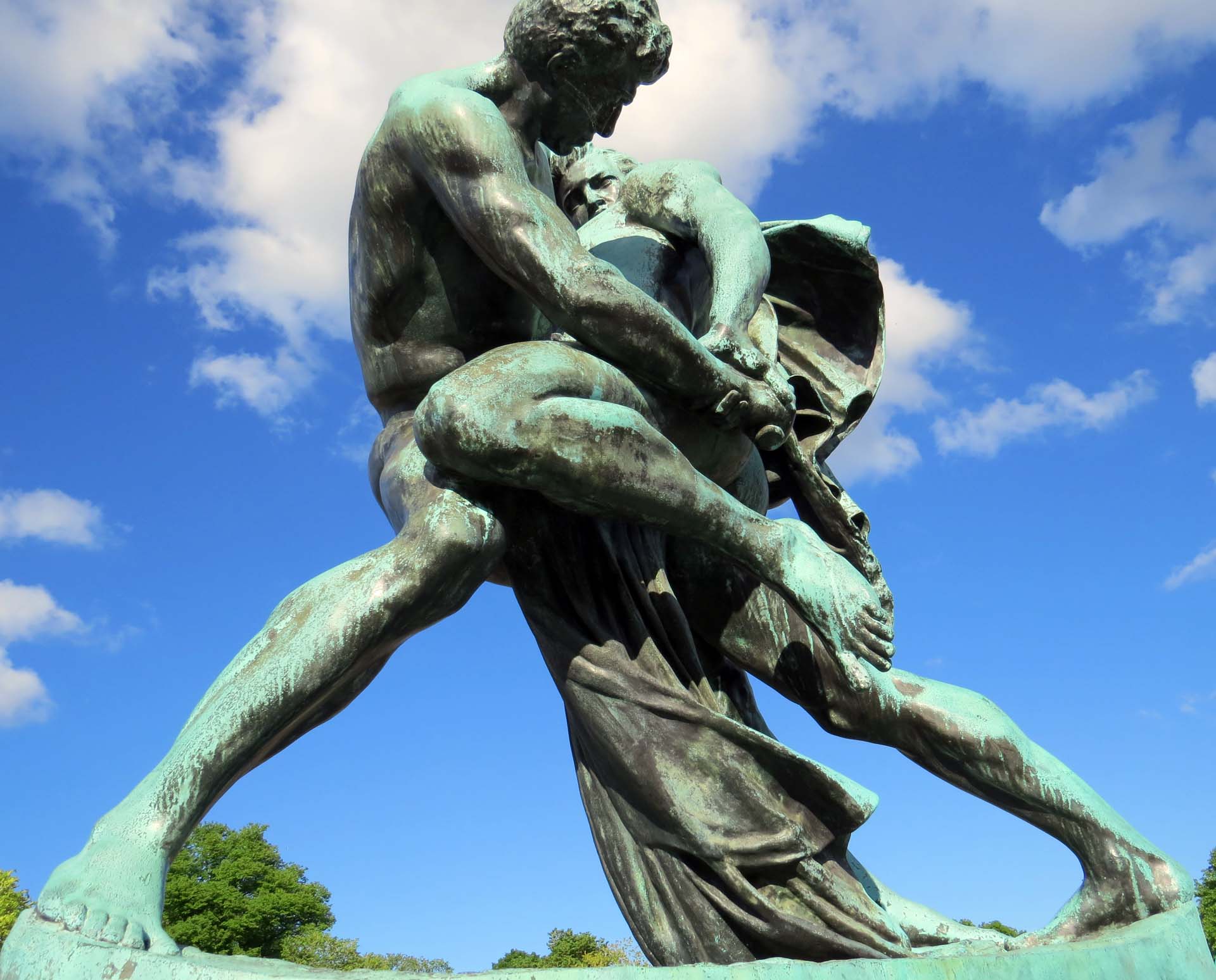This statue of two men fighting while belt-bound – bound together with the same belt – stands in Bältesspännarparken. It was made by Gothenburg sculptor Johan Peter Molin (1814-1873).
I originally published this on my daily photo blog GBG365 on 1st June 2013. At the time West Pride – Gothenburg’s LGBTQ+ Pride week was underway. Bältesspännarparken – The Belt-bound Fighters’ Park – was full of tents and rainbow flags and a carnival atmosphere. I had to stand in a rather cramped position to photograph the statue and I cropped off the top of one head. But I think it still works even so. (I’ve even sold an A3 size print of this photo, so at least one other person agrees!)
The Belt-bound Fighters
 The sculpture shows two men wrestling with knives as they are belted together with a single belt. Supposedly this was a method of duelling practiced in the Viking Age. The belt-bound fighters could not run away from one another and were forced to fight to the death. If you look at the reliefs that decorate the plinth the statue stands on, you get an idea of the story.
The sculpture shows two men wrestling with knives as they are belted together with a single belt. Supposedly this was a method of duelling practiced in the Viking Age. The belt-bound fighters could not run away from one another and were forced to fight to the death. If you look at the reliefs that decorate the plinth the statue stands on, you get an idea of the story.
The two men are friends or acquaintances. One has a girlfriend or a wife and everything starts peacefully enough. The two men sit together for a drink. The woman serves them (presumably mead or ale).
 The one becomes drunk and starts to pester the woman.
The one becomes drunk and starts to pester the woman.
The other man objects and challenges his friend to a duel. They fight, belt-bound, and one is killed.
 I guess it’s the boyfriend/husband who is killed as the final relief shows the woman grieving by his gravestone.
I guess it’s the boyfriend/husband who is killed as the final relief shows the woman grieving by his gravestone.
It’s an interesting combination of two 19th century interests – the “national romantic” Viking story combined with a lecture on the evils of drink.
 Some websites identify this sculpture as “The Knife Wrestlers”, but I’ve chosen to go back to the original Swedish for my title: Bältesspännarna – The Belt-bound (Fighters).
Some websites identify this sculpture as “The Knife Wrestlers”, but I’ve chosen to go back to the original Swedish for my title: Bältesspännarna – The Belt-bound (Fighters).
Bronze-skinned zinc
The sculpture dates from the 1860s, though the Swedish Wikipedia tells me Gothenburger Johan Peter Molin originally sketched it out in the 1840s. In 1858 Molin was working on it Paris. There he completed the first version in zinc and apparently exhibited it without generating much of a stir. It wasn’t until it was cast in bronze and exhibited in Berlin in 1862 that it started to attract interest. The same year Molin exhibited it at the London Exposition. Following this, Gothenburg was among several places that commissioned a version. (One went to Cologne and another was commissioned by an art dealer in Britain.)
I’m not sure whether it was an economy version Gothenburg ordered, but the bronze-skinned zinc statue didn’t stand up to Gothenburg’s climate. It was renovated in 1872 and when that version also decayed, it was replaced by a new (bronze only) statue in 1913. This was recast from the version that Molin made in 1867 for Stockholm’s National Museum.
It seems there is another version at the Powerscourt Estate in Ireland, perhaps the one the art dealer commissioned in 1862. That was also made with a bronze skin over zinc. It seems also to have suffered from the weather. There is a little picture essay about how it was restored on the website of Richard Harris Conservation Ltd.

